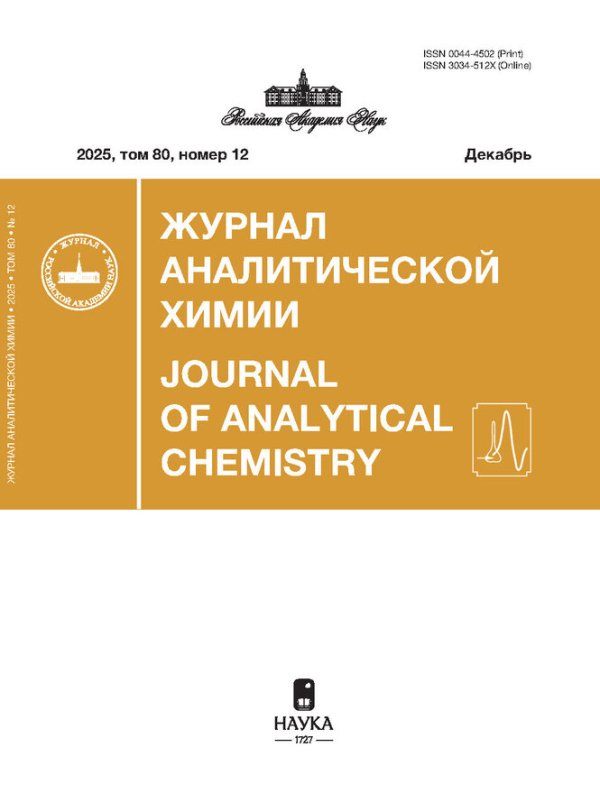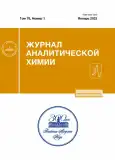Gas-Chromatographic Identification of Unusual Unstable Products of the Partial Hydrolysis of Tetraethoxysilane
- Authors: Zenkevich I.G.1, Baranov D.A.1
-
Affiliations:
- Institute of Chemistry, St. Petersburg State University
- Issue: Vol 78, No 1 (2023)
- Pages: 64-73
- Section: ORIGINAL ARTICLES
- Submitted: 14.10.2023
- URL: https://journals.rcsi.science/0044-4502/article/view/136011
- DOI: https://doi.org/10.31857/S0044450223010152
- EDN: https://elibrary.ru/KKVZCM
- ID: 136011
Cite item
Full Text
Abstract
Gas chromatographic analysis of a long-stored sample of tetraethoxysilane (tetraethyl orthosilicate) showed that it lacked the main component due to the hydrolysis of this compound by traces of water. Instead, ethanol and three other components with retention indices (RIs) of 537 ± 2 (no. 1), 608 ± 1 (no. 2, the most abundant component), and 727 ± 3 (no. 3) on a column with a HP-5 stationary phase were detected. These components are unstable, and they cannot be isolated preparatively; as a result, they have not been characterized previously. To identify them, the chemical properties of this sample were characterized, and the recurrent approximations of the RIs of the detected components and their correlation with the retention indices of structural analogs were considered. It was established that they were congeners of the initial tetraethoxysilane, namely, exotic products of its partial hydrolysis—triethoxysilanol (C2H5O)3SiOH, diethoxysilanediol (C2H5O)2Si(OH)2, and ethoxysilanetriol (C2H5O)Si(OH)3. In accordance with published data, some silanediols R2Si(OH)2 and silanetriols RSi(OH)3 are stable, especially, compounds containing substituents capable of conjugation with vacant d orbitals of silicon atoms. Among them are phenyl- (π–d conjugation systems) and alkoxy-substituted (p–d systems) silanediols and silanetriols. The identified products of partial hydrolysis of tetraethoxysilane belong to the latter type.
About the authors
I. G. Zenkevich
Institute of Chemistry, St. Petersburg State University
Email: izenkevich@yandex.ru
198504, St. Petersburg, Russia
D. A. Baranov
Institute of Chemistry, St. Petersburg State University
Author for correspondence.
Email: izenkevich@yandex.ru
198504, St. Petersburg, Russia
References
- Middleditch B.S. Analytical Artifacts: GC, MS, HPLC, TLC, and PC. Amsterdam: J. Chromatogr. Library. V. 44. 1989. 1033 p.
- Zenkevich I.G. Features and new examples of gas chromatographic separation of thermally unstable analytes / Chapter XX in “Recent advances in gas chromatography”. London: IntechOpen Ltd. 2020. P. 1. https://doi.org/10.5772/intechopen.94229
- The NIST Mass Spectral Library (NIST/EPA/NIH EI MS Library, 2020 Release). Software/Data Version; NIST Standard Reference Database, Number 69, May 2020. National Institute of Standards and Technology, Gaithersburg, MD 20899: http://webbook.nist.gov (дата обращения: апрель 2022 г.).
- Rama S., Zhang Y., Tchuenbou-magala F., Ding Y., Li Y. Encapsulation of 2-amino-2-methyl-1-propanol with tetraethyl orthosilicate for CO2 capture // Frontiers Chem. Sci. Eng. 2019. V. 13. № 4. P. 672. https://doi.org/1007/s11705-019-1856-6
- Ramamurthy A.S., Eglal M.M. Degradation of TCE by TEOS coated nZVI in the presence of Cu(II) for groundwater remediation // J. Nanomaterials. 2014. Article 606534. https://doi.org/10.1155/2014/606534
- Arkles B., Steinmetz J.R., Zazyczny J., Mehta P. Factors contributing to the stability of alkoxysilanes in aqueous solutions / Silanes and Other Coupling Agents / Ed. Mittal K.L. Utrecht: VSP, 1992. P. 91.
- Braddock D.C., Lickiss P.D., Rowley B.C., Pugh B.C.R., Purnomo T., Santhakumar G., Fussell S.J. Tetramethyl orthosilicate (TMOS) as a reagent for direct amidation of carboxylic acids // Org. Lett. 2018. V. 20. P. 950.
- The Merck Index – An Encyclopedia of Chemicals, Drugs, and Biological / Ed. O’Neil M.J. Whitehouse Station: Merck and Co. Inc., 2006. 657 p.
- Lide R.C. CRC Handbook of Chemistry and Physics. 88th Ed. Boca Raton: CRC Press (Taylor & Francis Group), 2007. P. 3.
- Taylor J.H. Gas chromatographic separation and infrared analysis of ethyl propyl silicates // J. Chromatogr. Sci. 1968. V. 6. № 11. P. 557. https://doi.org/10.1093/chromsci/6.11.557
- Ellren O., Peetre I.-B., Smith B.E.B. Gas chromatographic investigation of organometallic compounds and their carbon analogues. I. Determination, calculation, and correlation of Kovats retention indices for tetraalkoxysilanes // J. Chromatogr. 1974. V. 88. P. 295. https://doi.org/10.1016/S0021-9673(00)83154-4
- Peetre I.-B. Gas chromatographic investigation of organometallic compounds and their carbon analogues. II. Improved method for calculating retention indices of tetraalkoxysilanes // J. Chromatogr. 1974. V. 88. P. 311. https://doi.org/10.1016/S0021-9673(00)83155-6
- Крешков А.П., Кириченко Е.А., Марков Б.А. Индексы удерживания алкоксихлорсилано в // Журн. аналит. химии. 1975. Т. 30. № 2. С. 345.
- Иванова Н.Т., Франгулян Л.А. Газохроматографический анализ нестабильных и реакционноспособных соединений. М.: Химия, 1979. 232 с.
- Kovats’ retention index system / Encyclopedia of Chromatography. 3rd Ed. / Ed. Cazes J. Boca Raton: CRC Press (Taylor & Francis Group), 2010. V. 2. P. 1304.
- Stein S.E., Babushok V.I., Brown R.L., Linstrom P.J. Estimation of Kovats retention indices using group contributions // J. Chem. Inf. Model. 2007. V. 47. P. 975. https://doi.org/10.1021/ci600548y
- Lim J., Ha S.-W., Lee J.-K. Precise size-control of silica nanoparticles via alkoxy exchange equilibrium of tetraethyl orthosilicate (TEOS) in the mixed alcohol solution // Bull. Korean Chem. Soc. 2021. V. 33. № 3. P. 1067. https://doi.org/10.5012/bkcs.2012.33.3.1067
- Derivatization of analytes in chromatography: General aspects / Encyclopedia of Chromatography. 3rd Ed. / Ed. Cazes J. Boca Raton: CRC Press (Taylor & Francis Group), 2010. V. 1. P. 562.
- Compounds: Derivatization for GC analysis / Encyclopedia of Chromatography. 3rd Ed. / Ed. Cazes J. Boca Raton, CRC Press (Taylor & Francis Group), 2010. V. 2. P. 1165.
- Зенкевич И.Г., Лукина В.М. Хромато-масс-спектрометрическая характеристика диэтилкеталей алифатических карбонильных соединений // Аналитика и контроль. 2019. Т. 23. № 3. С. 410. https://doi.org/10.15826/analitika.2019.23.3.009
- Zenkevich I.G. Application of recurrent relationships in chromatography // J. Chemometrics. 2009. V. 23. P. 179. https://doi.org/10.1002/cem.1214
- Zenkevich I.G. Recurrent relationships in separation science / Chemometrics in Chromatography / Eds. Komsta L, Heyden Y.V, Sherma J. New York: Taylor & Francis, 2017. Ch. 24. P. 449.
- Toyoda T., Matsumoto T., Arakawa T. Jet printing ink composition. Patent USA. 1982. № 4,338,133.
- Kazakova V.V., Gorbatsevich O.B., Skvortsova S.A., Demchenko N.V., Muzafarov A.M. Synthesis of triethoxyxilanol // Russ. Chem. Bull. Int. Ed. 2005. V. 54. № 5. P. 1350.
- Nobutami K., Masao K. The crystal structure of diallylsilanediol // Bull. Chem. Soc. Jap. 1954. V. 27. № 9. P. 605. https://doi.org/10.1246/bcsj.27.605
- Tyler L. Phenylsilanetriol // J. Am. Chem. Soc. 1955. V. 77. № 3. P. 770. https://doi.org/10.1021/ja1608a078
- Korkin S.D., Buzin M.I., Matukhina E.V., Zherlitsyna L.N., Auner N., Shchegolikhina O.I. Phenylsilanetriol – Synthesis, stability, and reactivity // J. Organomet. Chem. 2003. V. 686. № 1–2. P. 313. https://doi.org/10.1016/S0022-328X(03)00721-6
- Jha S.K., Marina N., Liu C., Hayashi K. Human body odor discrimination by their GC-MS spectra data mining // Anal. Methods. 2015. № 7. P. 9549. https://doi.org/10.1039/C4AY02457A
- Pratana R.I., Yuniar I., Hamdani H., Rostini I. Volatile flavor compounds composition of fresh and steamed tiger shrimp (Penaeus monodon) // Int. J. Fish. Aquat. Res. 2019. V. 4. № 1. P. 25.
- Stefanikova J., Arvay J., Miskeje M., Kacaniova M. Determination of volatile organic compounds in Slovak bryndza cheese by the electronic nose and the headspace solid-phase microextraction gas chromatography – mass spectrometry // Slovak J. Food Sci. 2020. V. 14. P. 767. https://doi.org/10.5219/1300
Supplementary files


















